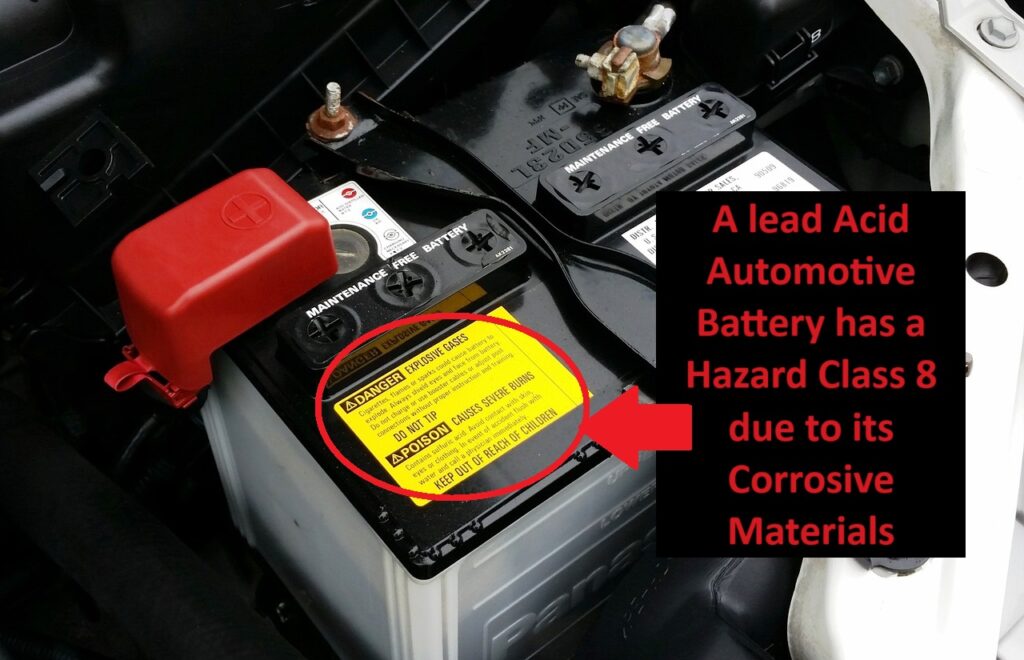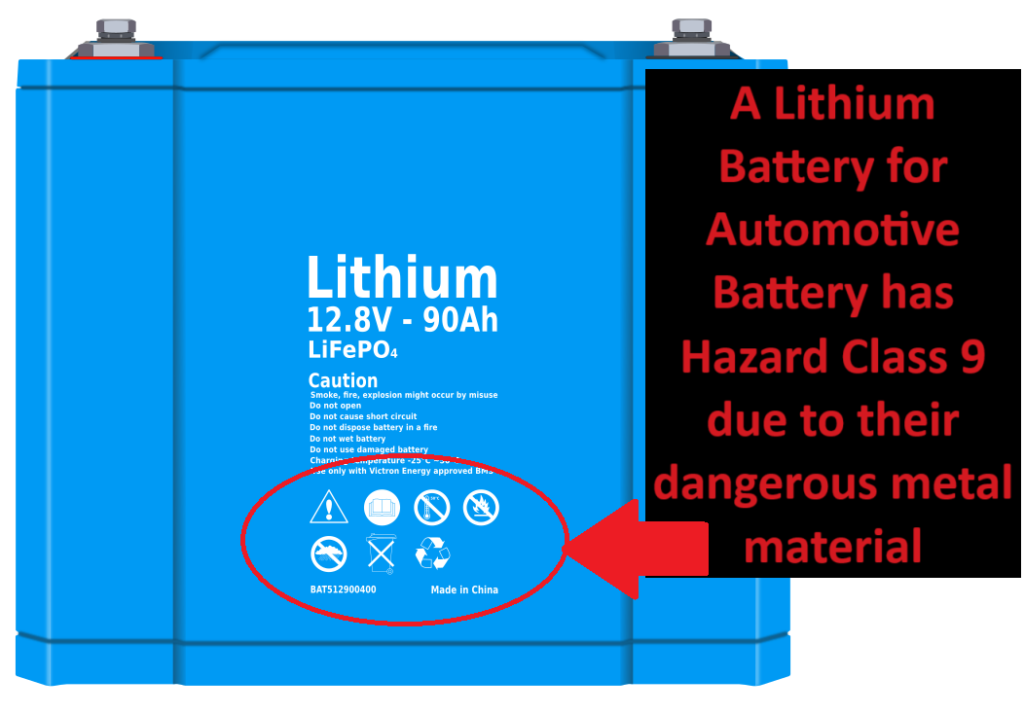Automotive batteries are an example of either hazard class 8 corrosive material or hazard class 9 miscellaneous hazardous materials. It depends on the type of the battery installed in your automotive. Their hazard class is defined by the material being used in the battery.
In this article, we will discuss in detail about automotive batteries are an example of which hazard Class, different types of batteries used in vehicles, and some general safety precautions involved in handling batteries.
What is a hazardous material?
A hazardous material is one that can causes harm when a human or environmental element comes in direct contact with it. For example acids or other harmful chemicals
Hazardous materials are classified into 9 different classes. These classifications are mainly issued by the US Department of Transportation (DOT).
Different Type of Hazard Classes
Following is a list of different hazardous class and sub classes defined by United State Department of Transportation
Hazard Class 1: Explosive
This class contain all those materials or objects that can cause a potential explosion. There the further siz divisions of this class.
| Division | Explosive Subclass |
| Dvision 1.1 | Mass Explosion Hazard |
| Division 1.2 | Projection Hazard |
| Division 1.3 | Fire Hazard and Minor Blast or Projection Hazard |
| Division 1.4 | Minor Explosion Hazard |
| Division 1.5 | Very Insensitive Explosives |
| Division 1.6 | Extremely Insensitive Explosives |
Hazard Class 2: Gases
This class contain all those material that are in gaseous state and are hazard to living organism. There are further three divisions of this class
| Dvision | Gases Subclass |
| Division 2.1 | Flammable Gases |
| Division 2.2 | Non-Flammable Gases |
| Division 2.3 | Poisonous Gases |
Hazard Class 3: Flammable Liquids
Hazard Class 3 is all about flammable liquids and are obious hazardous to living organisms. There is not subclass or division of this hazard class.
Hazard Class 4: Flammable Solids
Hazard Class 4 is all about flammable solids and are hazardous to living things. There are 3 subclass or division of this hazard class.
| Division | Flammable Solid Subclass |
| Division 4.1 | Flammable Solids |
| Division 4.2 | Spontaneously Combustible Materials |
| Division 4.3 | Dangerous When Wet |
Hazard Class 5: Oxidizers and Organic Peroxides
Hazard Class 5 ia about Oxidizers and Organic Peroxiders. These elements provide oxygen for burning process thus can burn independently. Means they does not relay of atmospheric oxygen to facilitate burning.
| Division | Subclass |
| Division 5.1 | Oxidizer |
| Division 5.2 | Organic Peroxides |
Hazard Class 6: Toxic and Infectious Substances
Hazard Class 6 is all about different Toxic and infectious substance. It contain all those substance that can cause infection to living organisms or are toxic for the environment.
| Division | Subclass |
| Division 6.1 | Toxic |
| Division 6.2 | Infectious Substances |
Hazard Class 7: Radioactive Materials
This class includes all those materials that are radioactive in nature. Means they emit radiation in their natural state. They does not have any further division or subclass.
Hazard Class 8: Corrosive Materials
This class includes all those materials that are corrosive in nature. Means they get or promote corrosion in their surrounding environment in their natural state. They does not have any further division or subclass.
Hazard Class 9: Miscellaneous Hazardous Materials
This class includes hazardous materials that do not fall into the other eight classes but still pose a risk during transportation.
Types of Automotive Batteries
A rechargeable electric battery is an important part of any car. It is responsible for providing electrical power for vehicle electronics and most importantly, starting the car. If not maintained properly these batteries can cause damage to vehicles or people dealing with it.
There are two main and most used types of rechargeable batteries for automotives.
- Lead Acid Battery
- Lithium Ion or Lithium Metal Battery
A lead acid battery is made up of lead plates that are submerged in sulphuric acid whereas a lithium ion battery is made up of lithium electrodes submerged in electrolytes like lithium hexafluorophosphate. Both batteries are rechargeable and their chemical can cause serious harm to humans if exposed.
Automotive batteries are an example of which hazard Class
A lead acid automotive battery has a hazard class 8 corrosive materials whereas a lithium automotive battery has a hazard class 9 miscellaneous materials. This hazard class if defined and assigned by the US Department of Transportation DOT. These hazard classes are due to the material being used in them.
Like any other product, an automotive battery has a fixed life. They need proper maintenance and careful handling during their useful life. These batteries do contain hazardous materials, so these batteries can cause serious damage if not handled properly.
Lead Acid Automotive batteries are which hazard class
Lead acid automotive batteries have hazard class 8 corrosive substances or corrosive materials. This class includes the materials (liquid or solid) that can cause irreversible damage to humans if exposed. This also contains materials that can cause corrosion of steel or aluminum at the rate of 6.25 mm per year.
In lead acid batteries, the lead and sulphuric acid both are proven to be corrosive toward other metals. Lead and sulphuric acid are also considered dangerious for humans if inhaled or swallowed. So due to this, these batteries are classified as hazard class 8 corrosive materials.
Lead tends to serve as the cathode to steel, aluminum, zinc, cadmium, and magnesium in various environments. Consequently, it has the potential to expedite the corrosion process of these metals.
Other than this the sulphuric acid used in lead acid automotive batteries is also very dangerous for humans. Due to acid in the battery the United nation has a special safety code for them. Hazard Class 8, UN2794 wet batteries filled with acid.

Lithium Automotive Batteries Hazard Class
Hazard class 9 of lithium automotive batteries is all about miscellaneous materials. Hazard class 9 contains all those dangerous materials which do not fall into any other hazard class.
The hazard class 9 of lithium batteries is due to the potential danger of electric shock or fire. This hazard class is more about their transportation. How they must be packed, handled and transported.
When used in automobiles, these lithium batteries can cause explosions and fires. So they must be treated with due care and as per the manufacturer recommendations.
It should be noted that lithium batteries fire cannot be put out by fire extinguishers. So it’s better to leave the vehicle and call the fire department for help.
These batteries are also assigned to a specific UN (United Nations) number within Class 9. Lithium batteries are commonly classified under UN number 3480 (Lithium-ion batteries) or UN number 3090 (Lithium metal batteries).
The subtance Lithium itself is generous for humans. Lithium has hazard class 4 division 4.3 dangerous when wet rating. If exposed to it can cause a lot of nausea, loss of appetite, extensive vomiting, serious diarrhea and an unusual abdominal pain.

Any individual who is in work of changing car batteries should seriously considered this and should follow all safety protocols.
What damage can these batteries acid cause?
Chemical use in these electrical batteries can cause serious damage to anyone who gets directly exposed to them. What damage can these batteries acid cause? These chemicals can cause
- Serious skin burn if came in contact with the skin directly or even over a piece of cloth
- Blindness if exposed to vapors of acid for too long
- Damaged lungs or respiratory problems if vapors are inhaled
Precautions to avoid damage from battery acids
This can be avoided if handled with care. Follow the mentioned precautions to avoid any type of damage from battery acids
- Always take proper training before handling any of these materials.
- Always use special gloves, glasses, boots, and dungaree before starting to treat these chemicals
- Never spill these acids on any type of land, if it happens by accident, remove them quickly.
- Always work on open or ventilated areas when handling these chemicals
- Always keep a first aid kit and emergency equipment near you
FAQ
Are automotive batteries corrosive materials ?
Yes, lead acid automotive batteries have lead in it and lead is a corrosive material. It is highly reactive with other metals like steel and promote their corrosion. Lead acid battery is an example of hazard class 8 corrosive material.
Last Words
Automotive batteries are an example of which hazard Class? A lead acid automotive battery is of hazard class 8 and a lithium automotive battery is of hazard class 9. If you have more information to share or questions to ask, do mention it in the comment section.
